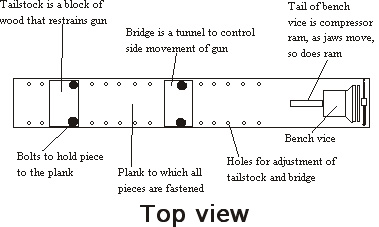Spring gun tuning part 2 : Building a mainspring compressor
Posted On Wednesday, 9 December 2009 at 06:21This is the most important tool a spring gun tuner owns. It may not be used for every job, but working without one when you need it is like walking a tightrope without a net. I now use a B-Square compressor, but for many years I used a homemade rig that did everything I asked of it. The plans for my compressor came from Tom Gaylord's Beeman R1 book. I've seen simpler compressors, but I've never seen one that was easier to make.
Mainsprings are under tension
To get maximum power from an airgun, the mainspring is usually under tension (compression). In modern spring guns, the trend is toward more compression than in the past. A few rifles such as the TX200 are under almost none - but they are the exception.
You can't contain it!
Never think you can contain the force of a mainspring. Eventually, you'll be able to do so with certain guns you have disassembled many times or even with certain gun models you may have learned very well; but the first time you work on a spring gun, you need to use a compressor.
Simple design
All a compressor does is restrain the rifle while relaxing (or decompressing) the mainspring with control. The task would be simple if all spring guns were built alike - but they aren't. I will address several different methods of gun design in a later posting. For now, just take my word that the compressor has to be very adaptable.
This compressor is built on a 2x8 piece of wood. All the parts attach to a plank.
The headstock, the bridge and the tailstock
The headstock contains the moving ram that compresses the mainspring. You can make a rugged one from a bench vise. There's really nothing to build! The vise is bolted to the plank and used in reverse. The tail of the vise puts tension on the end of the gun holding the mainspring.
The bridge is a tunnel through which the body of the gun passes. It keeps the body of the gun from moving sideways when the mainspring is under tension but not restrained by the gun.
The tailstock is a block of wood with the grain end exposed. The muzzle is pressed against it and the gun cannot move.
The bridge and tailstock are adjustable to accommodate different guns. They can also adjust for a gun that has the barrel on or off.


